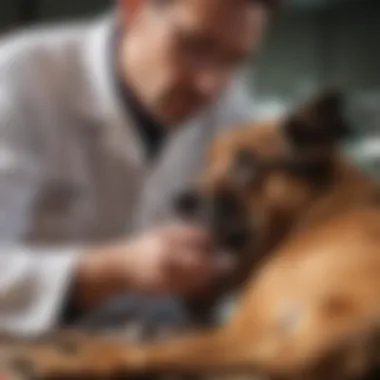Understanding Skin Tags in Dogs: Causes and Treatments


Intro
Skin tags in dogs, though generally harmless, are often a source of concern for pet owners. Understanding these growths is essential for maintaining your dog's health and making informed decisions about their care. This guide will explore the causes and characteristics of skin tags, how to distinguish them from other skin conditions, and when it becomes necessary to seek veterinary help. By gaining insights into this topic, pet owners can foster a greater sense of security and knowledge about their dogs' health.
Pet Care and Grooming
Taking care of your dog’s skin is an important part of overall health. Skin tags can be identified during regular grooming sessions. By examining your dog’s skin frequently, you're more likely to notice any changes, including new growths. Here are some key points about pet care and grooming:
Importance of Regular Care
Regular grooming helps maintain hygiene and can prevent various skin issues. Brushing your dog often removes dirt and loose fur. It is also a chance to spot abnormalities on the skin early.
Grooming Techniques by Pet Type
Different breeds may require specific grooming techniques. For example, poodles need regular clipping, while short-haired breeds may benefit from less frequent grooming but require more skin inspections.
Tools and Products Recommendations
Investing in quality grooming tools is wise. Combs, brushes, and clippers should match your dog’s specific coat type. Products like oatmeal shampoo can soothe sensitive skin.
Seasonal Care Tips
During seasons with high pollen or allergens, consider rinsing off your dog after outdoor activities. This helps reduce skin irritations and keeps skin healthy.
Health and Nutrition
Understanding the nutrition of your pet directly impacts their skin health. A balanced diet supports immune function, which can play a role in skin conditions.
Understanding Pet Nutrition
High-quality dog food with essential proteins and probiotics will help maintain healthy skin. Be cautious with common allergens like grain or chicken.
Common Health Issues by Species
While skin tags themselves are not dangerous, conditions like allergies or infections can accompany them. Regular check-ups are necessary for detection.
Preventive Care and Regular Check-Ups
Veterinary visits at least once a year allow for early detection of any health issues. Discuss with your veterinarian any concerns regarding skin tags.
Food and Dietary Advice
Consult your vet about specialized diets if your dog has skin issues. Omega fatty acids can improve skin vitality and help with inflammation.
Resources and Community Engagement
Gaining insights from others can be beneficial for pet owners dealing with skin tags and other health concerns.
Recommended Books and Websites
Books on dog care, like "The Dog’s Mind" by John Bradshaw, can provide valuable information. Websites like Britannica offer scientific insights into canine health.
Forums and Groups for Pet Owners
Community forums on platforms like Reddit can provide shared experiences and advice from other dog owners. Engaging with online communities can offer support.
Finding Local Services and Classes


Look for local training classes or veterinary services that focus on holistic pet health. These resources can enhance your understanding of skin issues.
Encouraging Community Sharing and Contributions
Sharing your own experiences regarding skin health and treatments can help others. Consider contributing to forums or local pet awareness programs.
"Understanding the specifics of skin tags can significantly enhance a pet owner's ability to provide proper care and timely veterinary intervention."
By familiarizing yourself with these aspects, you improve your dog’s well-being and your confidence in addressing any concerns. This direct engagement in your dog's health will lead to informed and compassionate pet care.
Foreword to Skin Tags in Dogs
Understanding skin tags in dogs is essential for pet owners. Many may think that skin tags are a sign of a more serious problem. It is crucial to recognize that while they are generally benign, many still have questions regarding their nature and implications. This section lays the groundwork for understanding what skin tags are, their characteristics, and why they appear in our pets.
What are Skin Tags?
Skin tags, medically referred to as acrochordons, are small, soft tumors that protrude from the skin. They often appear as tiny, fleshy bumps hanging from the skin, usually connected by a small stalk. Skin tags can vary in size and are commonly found in places where the skin folds, such as around the neck, under the armpits, and in the groin area.
While these growths are mostly harmless, monitoring their appearance is essential. Skin tags do not usually cause any discomfort to the dog, but they can sometimes become irritated, especially if they rub against clothing or other surfaces. Notably, they often develop in older dogs, though younger ones can be affected as well.
Common Myths and Misconceptions
There are numerous myths regarding skin tags in dogs that may cause unnecessary worry among owners.
- Skin tags can turn cancerous. This is not true; skin tags are generally benign. However, it is essential to ensure that any growths are correctly identified by a veterinarian.
- Only older dogs get skin tags. While it is more common for older dogs to have them, younger dogs can also develop skin tags due to genetic predisposition.
- Skin tags are contagious. Skin tags are non-infectious; they do not spread from one dog to another.
Causes of Skin Tags in Dogs
Understanding the causes of skin tags in dogs is crucial for pet owners. By identifying the underlying factors, pet owners can better manage their dog's health and be more aware of any potential risks. Skin tags are often benign, yet they can sometimes lead to concerns. Knowing what leads to their development can empower owners to make informed choices regarding treatment and care.
Genetic Predispositions
Some breeds are more susceptible to developing skin tags than others. This genetic predisposition can occur due to specific traits that certain dog breeds hold. For example, dogs like Cocker Spaniels, Labradors, and Boxers have a higher likelihood of experiencing skin tags. The presence of skin tags in these breeds may be due to inherent skin characteristics or immune responses.
Pet owners should take note of their dog’s breed and monitor for any skin changes. If a skin tag appears, especially in a breed prone to them, it can provide insights into the genetic background of the dog, offering a better understanding of what to expect.
Age-Related Factors
Age is another significant factor in the development of skin tags. Older dogs are generally more likely to develop skin tags because, as they age, their skin undergoes natural changes. This includes reduced elasticity and increased skin fold formation, both of which contribute to the emergence of skin tags.
In younger dogs, the immune system is typically stronger. However, as dogs age, they may experience a decline in immune function, making them more vulnerable to various conditions, including skin tags.
Regular vet check-ups for older dogs can be vital. It helps in screening for abnormal growths and understanding any associated health implications.
Environmental Influences
The environment where a dog lives can influence the occurrence of skin tags. Factors such as climate, exposure to allergens, and overall living conditions can play a role. For instance, dogs living in moist or humid climates may develop skin tags more readily due to friction and skin irritation from these conditions. Environmental stressors, such as exposure to different chemicals or pollutants, may also impact skin health.
Additionally, obesity in dogs can lead to skin folds, which may encourage the growth of skin tags due to increased friction in certain areas. Maintaining a healthy weight through diet and exercise is critical for preventing skin tags and other skin-related issues.
In summary, the causes of skin tags in dogs can often be traced back to genetics, age, and environmental factors. Understanding these aspects can significantly help pet owners in managing their dog's health effectively.
Identifying Skin Tags
Identifying skin tags in dogs is a crucial step for pet owners. Understanding their characteristics, differences from other skin conditions, and knowing when to seek veterinary advice can ensure that your dog receives appropriate care. Skin tags can appear harmless, but distinguishing them from other more serious skin issues is essential. This section will outline various aspects of skin tags to help pet owners make informed decisions about their dog's health.
Physical Characteristics of Skin Tags
Skin tags are typically small, soft growths that hang off the skin. They can vary in size from a few millimeters to several centimeters. Generally, skin tags are skin-colored or slightly pigmented. They usually have a smooth surface but may also appear wrinkled or folded.


Common attributes of skin tags include:
- Softness: Skin tags feel softer compared to other growths. You can usually pinch them gently without causing your dog pain.
- Movability: Skin tags tend to be movable and are not firmly attached to the underlying tissue.
- Non-painful: Most dogs do not show signs of discomfort or pain when skin tags are touched.
- Location: Skin tags may develop in various locations, including the neck, eyelids, and underarms.
Recognizing these physical traits can help you identify skin tags quickly, making it easier to monitor changes over time.
Differentiating Skin Tags from Other Skin Conditions
It is vital to distinguish skin tags from other skin conditions, such as tumors or cysts. While skin tags are generally benign, other skin issues can indicate more severe health concerns. Here are some characteristics to look for when differentiating skin tags from other conditions:
- Color and Texture: Skin tags usually have a smooth or slightly wrinkled texture. In contrast, tumors may have irregular surfaces or varied colors and shades.
- Growth Rate: Skin tags tend to remain constant in size over time. Rapid growth can signal a different issue, necessitating veterinary evaluation.
- Presence of Symptoms: If your dog shows symptoms like itching, bleeding, or inflammation around a growth, it may not be a skin tag.
These pointers can guide pet owners in recognizing when a skin condition might require professional assessment.
When to Seek Veterinary Advice
While skin tags are often harmless, there are circumstances when a veterinarian’s input is crucial. Pet owners should look for the following signs:
- Change in Size: If a skin tag grows larger rapidly, it could signify a more serious problem.
- Color Changes: Any significant changes in color might warrant a vet's examination.
- Bleeding or Inflammation: If your dog begins to experience any bleeding or signs of irritation around the skin tag, consult a veterinarian.
- Multiple Growths: The appearance of multiple growths over a short period may require further investigation.
In summary, being observant and taking action when necessary is essential for maintaining your dog's health. Regular check-ups and steady communication with a veterinarian can lead to early detection of potential issues, ensuring that your pet remains healthy and happy.
Health Implications of Skin Tags
The health implications of skin tags in dogs are often underestimated. While skin tags themselves are generally benign, understanding their presence is crucial for pet owners. It is important to recognize that not all skin growths are the same. Some may require more attention than others. Pet owners should prioritize a clear understanding of skin tags and the potential misunderstandings that can arise about them. In this section, we will examine the benign nature of skin tags, potential complications, and the risks that could arise if they are ignored or mismanaged.
Benign Nature of Skin Tags
Skin tags in dogs are usually harmless outgrowths of skin. They do not typically cause pain or discomfort. These growths can vary in size and may appear on any part of the body. Although they can be unsightly, their benign nature means they are not inherently dangerous. Commonly referred to as acrochordons, they consist mainly of loose collagen fibers and blood vessels. Skin tags seldom interfere with the dog's health or quality of life.
Yet, pet owners should maintain vigilance. For instance, if a dog’s skin tag becomes irritated or starts to bleed, it can indicate underlying issues that warrant further examination. Regular check-ups can help catch any changes early. Skin tags usually do not lead to serious health issues but understanding their benign nature helps in reducing unnecessary anxiety for dog owners.
Potential Complications and Risks
Even though skin tags are largely considered harmless, there are still potential complications and risks to be aware of. While a skin tag may not pose a direct risk, it can become problematic in certain situations:
- Trauma: Skin tags can be prone to injury if they are located in areas prone to rubbing against surfaces or can be caught on furniture, leading to bleeding and infection.
- Infection: An injured skin tag may become infected, which can introduce more serious health concerns. Infections can lead to abscesses or sepsis in severe cases, necessitating prompt veterinary attention.
- Misidentification: There is a risk that pet owners may mistakenly identify a more serious condition as a skin tag. Other skin issues, such as warts, papillomas or even tumors, may resemble skin tags yet require different treatment approaches. Regular veterinary evaluations are essential to clear up any uncertainties.
It is vital for pet owners to differentiate between benign skin tags and other growths that may require veterinary intervention.
Diagnosis of Skin Tags
Diagnosing skin tags in dogs is a crucial step for pet owners in ensuring their furry companions' health. Skin tags can often mimic other skin conditions, leading to confusion among pet owners regarding their significance. Identifying these growths accurately can prevent unnecessary stress and cost. Early diagnosis allows for appropriate monitoring and intervention, ensuring that any changes in a dog’s skin condition are addressed in a timely manner.
A thorough understanding of the importance of diagnosis in skin tags involves recognizing both the potential benign nature of these growths and the necessity for proper assessment by a veterinarian. Many pet owners may not realize that while skin tags are generally harmless, they can occasionally signal other underlying health issues. Effective diagnosis not only alleviates concerns but also contributes to the overall well-being of the dog.
Role of the Veterinarian in Diagnosis
The veterinarian plays a fundamental role in the diagnosis of skin tags. Their expertise is essential in distinguishing between skin tags and other more serious conditions, such as tumors or infections. A skilled veterinarian will begin the diagnosis through a comprehensive physical examination. They may inquire about the dog’s health history, including any changes in behavior or other symptoms.
Veterinarians are trained to recognize the specific characteristics of skin tags. They will assess the size, shape, color, and location of the growths. If they deem necessary, they might recommend further testing to gather more information. This can include skin scrapings or biopsies to rule out malignancies or other skin disorders. Such thorough examination ensures that pet owners receive an accurate diagnosis and are guided towards the best course of action for their pet's care.
Diagnostic Procedures and Tests
Several procedures can assist in diagnosing skin tags in dogs. The most common diagnostic tests include:
- Visual Examination: The initial step often involves a visual inspection of the growths.
- Skin Scrapings: This helps in assessing any potential skin infections or parasites.
- Biopsies: Sometimes, a small tissue sample may be taken from the growth to determine its nature.
- Diagnostic Imaging: In rare cases, imaging techniques such as ultrasound might be employed to evaluate deeper tissues if a more complex skin issue is suspected.


Pet owners should be aware of these tests and commendably communicate any observed changes in their dog's skin. For instance, a rapid change in size, color, or the presence of additional symptoms such as itching or bleeding should prompt a visit to the veterinarian. Remember, accurate diagnosis of skin tags is vital in ensuring the right treatment and maintaining the overall health of the dog.
Treatment Options for Skin Tags
Treatment options for skin tags in dogs are essential to consider for various reasons. Understanding these options can help pet owners make informed decisions regarding their dog’s health. Skin tags, although typically benign, can sometimes be a source of discomfort or irritation for the animal. Treatment may be necessary if the skin tags become notably bothersome or if there are concerns about their appearance. Key considerations include the dog's overall health, age, and the potential for skin tags to change over time.
Veterinarians can guide owners through the available treatment options, ensuring that each pet receives the most appropriate care. It’s important for owners to understand that not all skin tags require treatment. However, if intervention is recommended, knowing the available methods can empower owners with the right knowledge to proceed in the best interest of their pet's well-being.
Surgical Removal of Skin Tags
Surgical removal is one of the most common methods for treating skin tags. This procedure is typically straightforward and performed by a veterinarian. During the process, the vet will use local anesthesia to ensure the dog is comfortable. Surgical removal may be necessary if skin tags are large, obstructive, or have signs of irritation.
Benefits of surgical removal include:
- Quick resolution: Once removed, the skin tags do not typically regenerate.
- Immediate relief: Dogs often show signs of relief right after the tags are removed, especially if the tags were causing discomfort.
- Pathological assessment: Removed tags can be sent for testing to rule out more serious conditions.
However, owners should consider the following before opting for surgery:
- Anesthesia risks: Like any surgical procedure, there are risks associated with anesthesia, especially in older dogs.
- Recovery: Post-surgical care is needed to ensure the site heals without infection.
- Cost: Surgical treatments can be more expensive compared to other options.
Non-Invasive Approaches
Non-invasive approaches for treating skin tags involve methods that do not require surgery. These options might be suitable for small, non-irritating tags or for dogs that may have health concerns making them poor candidates for anesthesia. Available non-invasive options include:
- Cryotherapy: This technique involves freezing the skin tag with liquid nitrogen.
- Laser therapy: Specialized lasers can effectively remove skin tags without a surgical cut.
- Topical treatments: Certain creams may be used to try to shrink the skin tags, although results can vary.
Non-invasive treatments offer the advantage of minimal recovery time and lower risk. However, they may also have limitations, such as:
- Effectiveness: Some non-invasive methods may not be as effective as surgical removal.
- Multiple treatments needed: Non-invasive methods may require several sessions to achieve desired results.
Ultimately, the choice of treatment for skin tags should be made in collaboration with a veterinarian. They can provide tailored advice based on the specific needs of each dog to ensure optimal health outcomes.
Prevention Strategies
Preventing skin tags in dogs can be a significant step in ensuring your pet's overall well-being. While skin tags themselves are mostly benign, understanding their potential emergence can help mitigate concerns for both pet owners and their canine companions. Here, we will explore two primary strategies: performing regular skin checks and maintaining overall dog health.
Regular Skin Checks
Regular skin checks are essential for every dog owner. Taking time to inspect your dog's skin can lead to early detection of skin tags or any changes in their condition. During these checks, look closely for any new growths, changes in color, or alterations in texture. Use the following steps for effective skin checks:
- Create a Routine: Develop a schedule to check your dog's skin, such as weekly or bi-weekly. Consistency can help you spot changes early.
- Examine Thoroughly: Check all areas of your dog's body. Pay attention to common spots like under the legs, around the ears, and around the neck.
- Use Touch: Feel for any lumps or bumps during the visual check. Sometimes, a tag may not be immediately visible, but it can be felt.
- Document Changes: Keep a record of any changes observed. This can be helpful when consulting a veterinarian.
By practicing regular skin checks, you foster a closer relationship with your pet's health. This way, you can ensure that any concerning developments are quickly addressed, minimizing complications.
Maintaining Overall Dog Health
The second preventive measure involves maintaining your dog's overall health. A healthy dog is less likely to develop various skin issues, including skin tags. Consider the following aspects to support your dog's health:
- Balanced Diet: Feed your dog high-quality nutrition that meets their specific needs. Proper vitamins and nutrients can help fortify the skin.
- Regular Exercise: Ensure your dog gets enough physical activity. Regular exercise promotes healthy circulation, which can contribute to skin health.
- Hydration: Always provide fresh water to keep your dog hydrated. Hydration is vital for maintaining skin elasticity and overall health.
- Grooming: Regular grooming helps remove dead hair and skin, which can prevent irritation and skin conditions. Use appropriate products suited to your dog’s coat type.
- Routine Veterinary Visits: Schedule regular check-ups with a veterinarian to ensure that your dog remains healthy. Early diagnosis of potential issues is important.
"Keeping your dog healthy and happy is a commitment that extends beyond just daily walks. It involves constant vigilance and proactive care to prevent issues before they arise."
Through attention and care, pet owners can contribute significantly to their dogs’ quality of life.
The End
The topic of skin tags in dogs holds significant importance for both pet owners and veterinary professionals. Understanding skin tags is essential because it not only helps in differentiating these growths from more serious skin conditions but also allows for timely interventions if necessary. Skin tags are mostly harmless, yet their presence may signal underlying health issues or simply be a part of the aging process in your dog. Therefore, being informed is beneficial in ensuring your dog's well-being and overall health.
Summary of Key Points
- Skin tags are common benign growths found on dogs, primarily due to genetic factors and age.
- Differentiating skin tags from other skin conditions is crucial for proper diagnosis and treatment.
- Regular veterinary check-ups can help ensure any skin changes are monitored appropriately.
- Treatment options include surgical removal or non-invasive procedures, depending on the specific case and needs of the dog.
- Preventive strategies, such as regular skin checks and maintaining overall health, reduce the risk of complications.
Encouragement for Pet Owners
As a pet owner, it is important to regularly observe your dog for any changes in skin appearance. If you notice any new growths, it’s wise to consult your veterinarian for a professional opinion. This proactive approach can help prevent potential complications and ensure that your pet lives a healthy and happy life. Remember, knowledge is power. By staying informed, you can make better choices about your dog's care and health.















